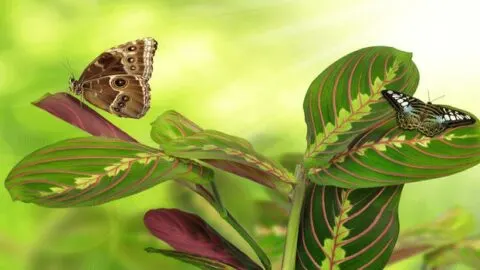The green leaves with red veins look spectacular, making this Maranta stand out.
But there’s more to this beautiful houseplant than just that.
For instance, Maranta leuconeura sports leaves that are susceptible to night and day.
What does that mean?
Well, it means that our leafy friend raises its leaves in the morning and then folds them at night.
This is also why Maranta leuconeura also goes by the mysterious name of the Prayer plant.
Maranta kerchoveana is another older name if you want to believe NC State University.
Now, without further ado, let us look at the ideal plant care for this beautiful evergreen perennial plant.
Maranta leuconeura Care
Maranta leuconeura care requires an airy potting mix of peat moss, sand, perlite, and a soil pH of 5.5 to 6. The temperature should be 65―80°F (18-27 degrees °C). Provide bright indirect light from an eastern, western, or northern window. Water about once a week and keep the soil slightly moist. Aim for humidity above 60%. Fertilize every two weeks with a fertilizer diluted to half-strength in spring and summer and reduce it to once a month in winter and autumn.
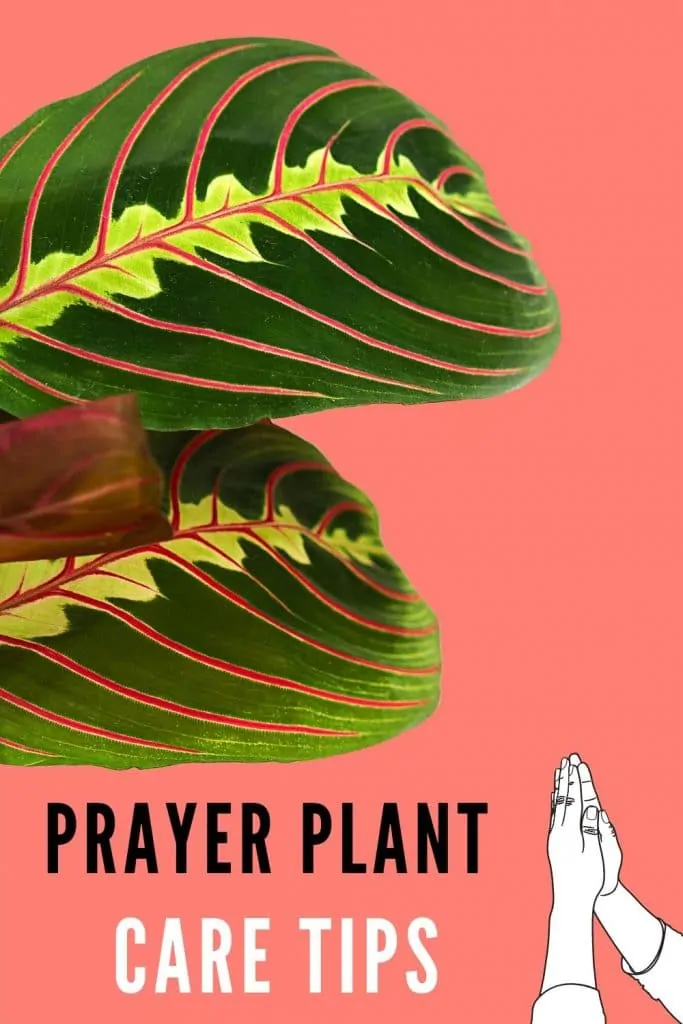
Table of Contents
Maranta leuconeura Care Guide (Prayer plant)
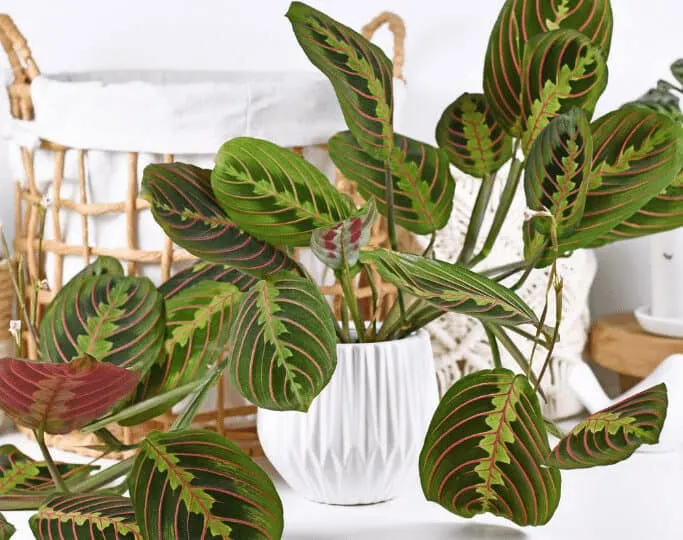
Soil
Maranta leuconeura provides an airy, well-draining potting soil mix consisting of peat, perlite, and sand.
Aim for a soil pH value of 5.5 to 6.
Alternatively, the Prayer plant can also be well cultivated in hydroponics.
Cultivation in hydroponics has the advantage that optimal water storage can be achieved much more easily.
Light
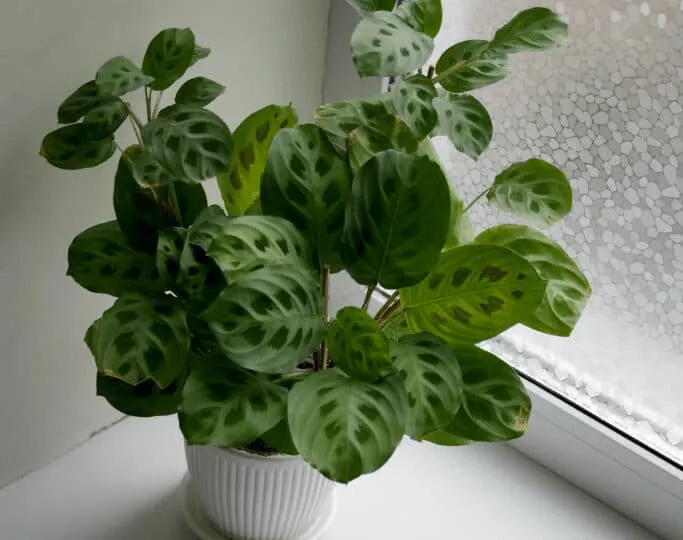
Maranta leuconeura prefers bright indirect light.
In winter, moving your Prayer plant to a sunnier spot is generally a good idea.
Provide it with an eastern, western, or northern window.
This way, the Prayer plant will get bright indirect light for larger parts of the day.
An eastern window will have just a few hours of direct light in the morning.
This is fine as the sun is not strong in the morning, and 3-4 hours of direct sunlight will be tolerated.
The Prayer plant does also well under growing lights.
Watering
Your goal should be to keep the soil slightly moist at all times for Maranta leuconeura.
Waterlogging should be avoided, therefore letting the soil dry out between waterings.
Watering your plant about once a week during the growing season should do the trick.
In winter, your Maranta will need less water.
What kind of water should you use?
Not only the amount of water is decisive for watering, but also the type of water.
With Maranta leuconeura, you should avoid giving limy water because it does not tolerate this.
It is, therefore, best to use either soft water, distilled water, or rainwater.
Temperature
As is true with many other houseplants, Maranta leuconeura thrives pretty well at room temperature and can tolerate anything from 65―80°F (18-27 degrees °C).
As is true with many other houseplants, Prayer plants do not respond well to sudden changes in temperature. This could even be fatal for your plant.
According to the University of Florida, Maranta leuconeura grows yearly in USDA hardiness outdoors zones 10B to 11.
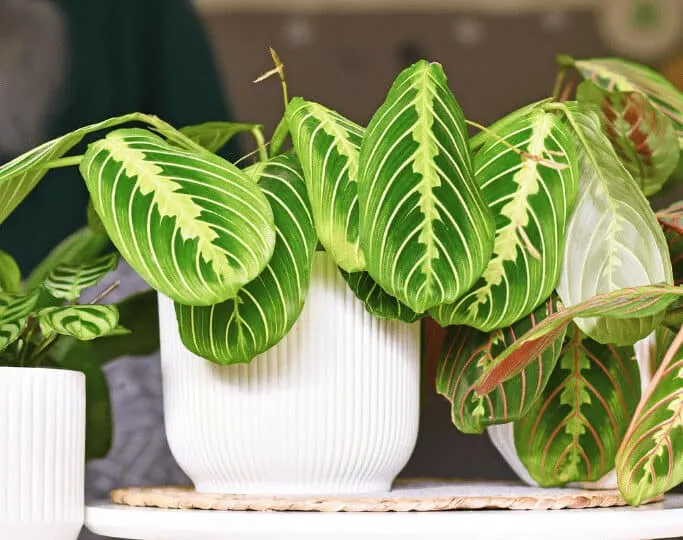
Humidity
Prayer plants like it humid. A humidity of 60% and higher is perfect.
So keep the humidity high.
To ensure decent humidity levels, you might want to move your Prayer plant in the bathroom.
However, there are other ways to meet the humidity needs of your Prayer plant. One way to keep your plant happy is to mist it regularly.
Another way to raise the overall humidity is by keeping the plant on a bed of damp pebbles.
Also, you could bless your Prayer plant with some plant neighbors, as having other plants around it will also help increase the overall humidity.
Fertilizer
As far as fertilizer goes, a Prayer plant has no special requirements.
Feeding your plant every two weeks with half-diluted liquid fertilizer during the growing season (spring and summer) is sufficient.
Feeding your Prayer plant once a month produces the best results in colder months.
Regarding the choice of fertilizer, a balanced houseplant fertilizer will do the trick.
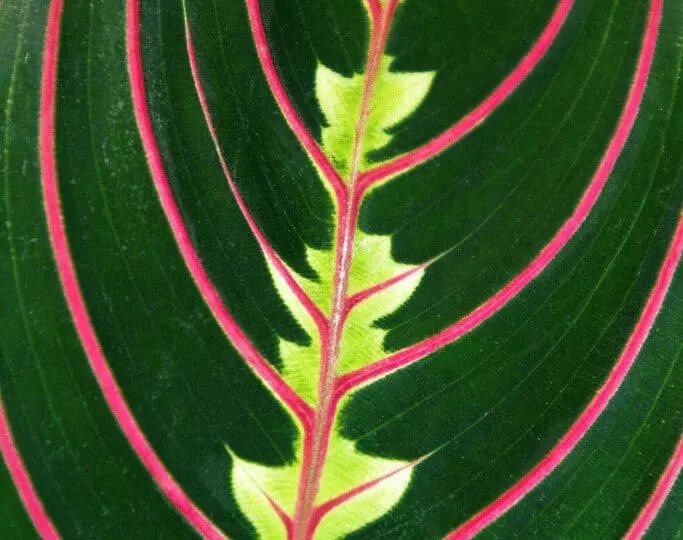
Propagation
Maranta leuconeura is best propagated through stem cuttings. However, it can also be propagated by division during repotting. Repotting is best done in spring.
Growth
Maranta leuconeura is a low-growing plant with a horizontal growth habit. They grow up to 12 inches (30 cm) tall and 18 inches wide (45 cm). Its oval leaves are between 4 to 8 inches (10 to 20 cm) long.
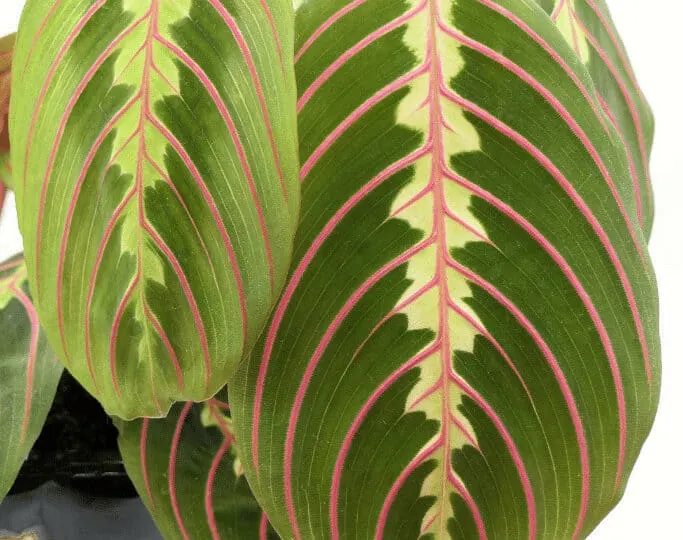
(Re)potting
While many houseplants only need to be repotted when outgrowing their pot, Maranta leuconeura benefits from annual repotting.
The main reason is that your green companion will again be blessed with fresh, well-aerated soil that way.
There is not much to consider when repotting your Player plant. Flat containers are well suited, as Prayer plants are shallow-rooted plants. Repotting is best done in spring.
If you have grown your plants in hydroponics, repotting is not necessary as long as they are in sufficiently large containers.
Propagation of Maranta leuconeura
Stem cuttings best propagate Prayer plants.
Here are some easy steps to follow to make sure the propagation of your green companion will be successful:
Step 1: Search your Prayer plant for healthy stems.
Step 2: Use a sharp, sterile knife to proceed with the cuttings.
Step 3: The cuttings must be done directly below the leaf node.
Step 4: Dip the freshly made cutting in a rooting hormone.
Step 5: Then, put the cuttings in a glass of water. Make sure to use soft water for that purpose.
Step 6: Change the water regularly. Once every two days or even once a day will yield the best results.
Step 7: As soon as the first roots show and new leaves can be seen at the top, you can put the cutting in the soil.
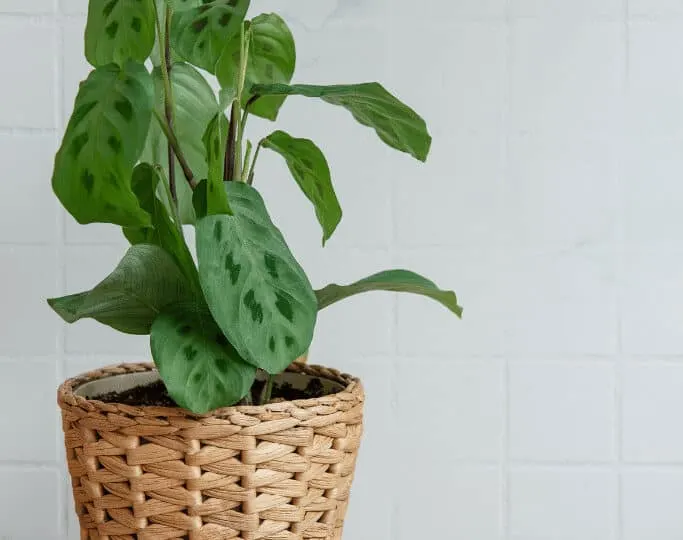
Pruning your Prayer plant
Pruning is not necessary for the well-being of your Prayer plant. However, it helps encourage more vigorous growth.
Trimming also helps in ensuring that your Prayer plant stays bushy and shapely.
Prayer Plant SOS
Problem: Pale leaves
Cause: Pale leaves are usually a sign of too much sunlight. If you spot faint webbing on the undersides of the leaves, you might also be dealing with spider mites.
These creatures are really small, so you might need a magnifying glass even to see them.
Remedy: Keep your plant out of direct sunlight. Prayer plants like bright indirect sunlight. If Spider mites are the cause, the first thing you want to do is to isolate your plant.
After that, get rid of badly infected parts of your plant.
To save the rest of your plant, you need to clean it properly. Use water and a little soap for that purpose (together with a cloth).
After that, you will have several options to go to war with Spider mites.
One proven way to eliminate Spider mites is to use an insecticide. Also, keep the humidity high by misting your plant regularly (even daily).
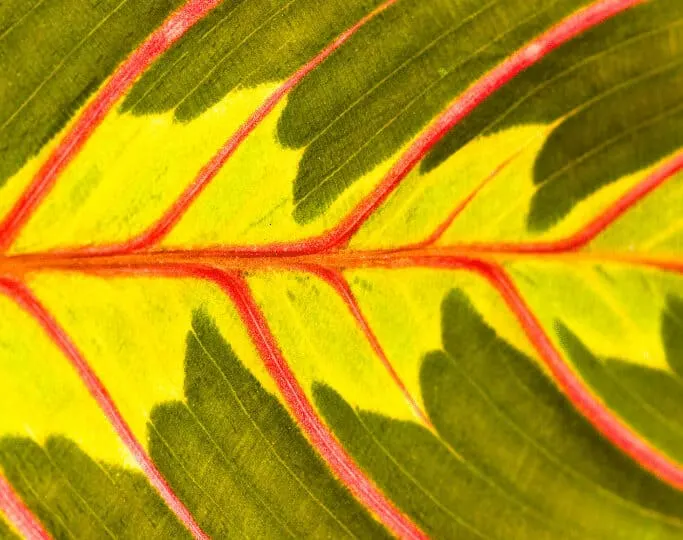
Problem: Curly leaves and brown spots
Cause: Either too dry or too cold. If some of the leaves of your Maranta leuconeura are only slightly curled, this could also be an indicator of too much light.
Remedy: If the soil is too dry, you must give your plant some more water. If too cold, you might need to move your Prayer plant to a new location.
Problem: Mealybugs
Cause: A few possible causes for a mealybug infestation of your Prayer plant.
It might be that you have contaminated soil, or maybe you recently bought an already-infested plant.
Unfortunately, that happens pretty often.
So when buying any houseplant, you should inspect the plant carefully and check for possible infestations.
Remedy: Mealybugs are sneaky little creatures, indeed. But it could be worse.
Spider mites, for instance, are certainly a worse plague for your plants than Mealybugs, and there is still hope for your plant.
So how do you get rid of these little white creatures? First, you should quarantine your plant to prevent this plague from spreading to other plants.
After that, wipe off the mealybugs with a damp cloth or cotton bud soaked in alcohol (insecticide). However, it is not quite that easy to get rid of Mealybugs.
If all this doesn’t work, you may have to throw the plant away. Good luck!
5 Tips to keep your Maranta leuconeura happy
- Keep the humidity high. Mist your Prayer plant regularly.
- Keep out of direct sunlight.
- Prune your Prayer plant from time to time to encourage more vigorous growth.
- Use flat containers for your Prayer plant, as you are dealing with a shallow-rooted plant.
- Use water low in lime (soft water) when watering your Prayer plant. Both distilled water and collecting rainwater are also acceptable for your Maranta leuconeura. Too much lime in the water can cause brown spots on the leaves.
Is Maranta leuconeura easy to care for?
Maranta leuconeura is relatively easy to care for and very suitable for indoor cultivation.
As far as the propagation of the plant is concerned, this can also be done relatively easily by propagating the plant using stem cuttings.
Since the Prayer plant is a tropical plant, it is important to keep the humidity high to ensure it can thrive to its full potential.
The general rule for houseplants is always that the plant’s natural environment should be simulated as well as possible.
So if a plant is exposed to high humidity in its natural environment, you should create a similar environment for the plant at home.
If you have only recently turned to the hobby of houseplants and would like to raise plants that are very easy to cultivate, then we can recommend the following plants, among others: Spider plants, Peace Lilies, Snake plants, Pothos.
Beginners very often tend to supply their plants with too much water. One plant that is very resistant to overwatering is the Chinese Evergreen.
So if you like giving lots of water, this plant might be right for you.
Toxicity
Maranta leuconeura is pet-friendly. These plants are non-toxic to cats and dogs as well as humans.
Frequently Asked Questions
Why is Maranta leuconeura called Prayer plant?
What about the longevity of Prayer plants?
When should I report my Prayer plant?
Can I grow Maranta leuconeura under fluorescent light?
My Prayer plant’s leaves are very pale. What’s wrong?
Is the Prayer plant prone to plant pest infestation?
Does the Prayer plant flower when kept as a houseplant?
Is Maranta leuconeura toxic to cats?
Is Maranta leuconeura toxic to dogs?
Any display tips for Prayer plants?
What are some of the most striking varieties of Maranta leuconeura?

Daniel has been a plant enthusiast for over 20 years. He owns hundreds of houseplants and prepares for the chili growing seasons yearly with great anticipation. His favorite plants are plant species in the Araceae family, such as Monstera, Philodendron, and Anthurium. He also loves gardening and is growing hot peppers, tomatoes, and many more vegetables.

